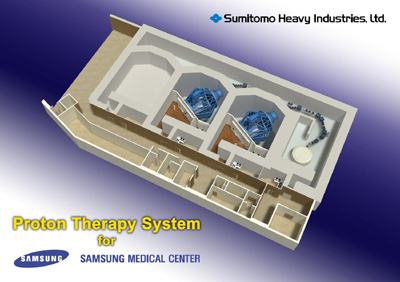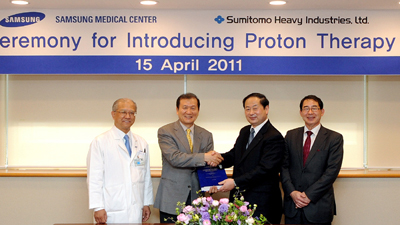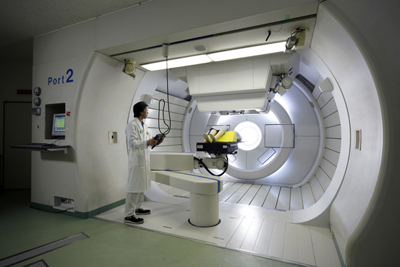Contract concluded for installation of proton therapy cancer treatment facility at Samsung Medical Center in Korea
April 21, 2011
On 15th April, 2011, Sumitomo Heavy Industries (hereinafter referred to as "SHI"; President: Yoshinobu Nakamura) signed the implementation contract for the Proton Therapy System with Samsung Medical Center (Seoul, Korea), which is the key hospital of the Samsung Group in Korea.
The Samsung Medical Center, (1,951 sickbeds) established in 1994, is equipped with state of the art latest medical infrastructure and has been globally promoting diagnosis, research and education. This hospital has been voted as the leading hospital by client satisfaction research in Korea, by providing the best diagnosis and patient-oriented services.
The proton therapy cancer treatment facility, for which the order was made, is equipped with two sets of rotating gantry irradiation system, that have been proven at the National Cancer Center Hospital East in Kashiwa, Japan. The facility allows the selection of either the pencil beam scanning irradiation method, which is a cutting edge irradiation technology, or the conventional irradiation method (wobbler method), in accordance with the shape of a targeted tumor. Furthermore, Intensity Modulated Proton Therapy (IMPT) is applied to this facility, as it features a highly precise patient positioning system with a combination of a six-axis, robot operated treatment couch and x-ray Digital Radiography (DR) System. This proton therapy cancer treatment facility is planned to be implemented in the newly established Proton Therapy Center, with the installation work scheduled to be completed by November 2014.
Proton beam therapy is a kind of radiotherapy that involves accelerating protons, which are the nuclei of hydrogen atoms, to a high energy level before irradiating and concentrating them on cancer tissues only. Since healthy tissues in the vicinity of the cancer tissues are not negatively impacted it is possible to provide a therapy with little side effects. Unlike surgical procedures, this is a low impact treatment that allows patients to be treated as outpatients and for this reason it is attracting attention around the world.


SHI has been researching and developing of proton beam therapy cancer treatment facilities for over 30 years.
In 1997 SHI delivered a proton beam therapy cancer treatment system for installation in the National Cancer Center Hospital East (currently the National Cancer Center Research Institute Hospital East), which was the first in Japan and second in the world. Since then, sales activities were implemented both domestically as well as overseas, making this the sixth order (fourth from overseas). SHI will continue to contribute towards the wide use of proton beam therapy for cancer treatment around the world, with the proton therapy cancer treatment facilities incorporating state of the cutting edge technologies, and in collaboration with customer medical institutions.
1. Features of proton beam therapy
A proton beam is a kind of charged particle beam. Radiation is obtained by accelerating the proton, which is the atomic nucleus of hydrogen. When directed on a human body, the beam rapidly emits energy at a specific depth and then vanishes, which is a physical characteristic that is not available with x-rays, more commonly used for radiotherapy. This is referred to as the "Bragg Peak". It is possible to target cancer tissues with the maximum amount of radiation without adversely impacting the healthy tissues in the vicinity, by adjusting the depth and width of the Bragg Peak. For example, it is possible to treat with an adequate dose of radiation to cancer tissues beside of the brain, heart, intestinal organs and other such vital organs with less harmful side effects.
2. Proton therapy cancer treatment system
[Accelerator]
Protons are accelerated to an energy level 230MeV*2 with a cyclotron*1 that is dedicated to cancer treatment.
[Beam transport equipment]
Proton beams generated by the cyclotron are accelerated and regulated to energy amounts required by individual patients and transported to the rotating gantry irradiation equipment.
[Rotating gantry irradiation System]
The use of a rotating gantry makes it possible to irradiate targeted cancer tissues with proton beams from any angle in a 360 degree range, thereby alleviating patients from assuming uncomfortable postures. The system is equipped with patient positioning equipment, a robotic treatment couch and an irradiation nozzle. Proton beams guided with the gantry beam transport system are formed by the irradiation nozzle in suitable shape to meet the target tumor's figure.

*Note 1: Cyclotron:
This is a type of circular accelerator. It accelerates protons, which are the nuclei of hydrogen atoms, to about 60% of the speed of light to generate proton beams with a large penetrating force. It features superior adaptability for lung, liver and respiratory organs because of the beam's characteristics, which are higher in intensity and more continuous in comparison with other accelerators, offering a performance that makes it possible to shorten the treatment time and frequency.
*Note 2: MeV: Mega Electron Volts.
Electron volt (eV) is a unit of energy. On million eV is equivalent to 1MeV.
